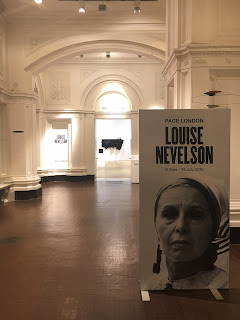Times (temples) Change (2009)
I am a huge admirer of installation art. I am fascinated at how such work not only transforms the perception of a space, but
also the passive act of looking into an immersive experience. For me, the scale and spectacle of the best
of such art - the interruption between what is expected and what is experienced
– has the unique ability of focusing all my attention on just the work and
temporarily shutting out all the white noise that usually reverberates around my
head. I find that interventions
of contemporary art in historical architectural settings (for example Kate
Mccgwire at Tatton Park and Sarah Lucas at Sir John Soane’s Museum), can offer a
similar experience and I always look forward to visiting non-gallery spaces which
showcase contemporary art. I find such
juxtapositions fascinating, so the prospect of seeing the master of Italian Arte
Povera in the eighteenth century splendour of an English country house, was an appealing
one.
The director of Blenheim Art Foundation, Michael Frahm,
eloquently set out the reasons for inviting Pistoletto to Blenheim Palace (the
artist’s most ambitious exhibition to date in the United Kingdom) and how his
work both compliments and disrupts the Palace’s Baroque setting, in a very
professionally produced booklet. The little
booklet was a helpful and welcome companion to my visit. Strategically placed in a number of Blenheim’s
ground floor rooms, the impact of Pistoletto’s work within the spaces varied
greatly. The monumental The
Third Paradise (2003-16) in The Great Hall could not fail to impress –
the artifice referred to in the theory behind the piece along with its
materials of foam, rags and aluminium contrasting strikingly against the artifice
of the ornate ceiling decoration. The
spectacle of that piece almost eclipsed some of the work around it
(particularly Top Down, Bottom Up, Inside Out (1976) tucked into an alcove on
the west side of the Great Hall.
The Third Paradise (2003-16)
Unfortunately, Contact (2007) had been removed due
to damage which I found out after asking an attendant having tried in vain to
find it in the north corridor, as indicated the gallery guide.
Beautiful pieces like Dog in the Mirror (1971), Mica
Paintings (1976) and Painting of Electric Wires (1967)
resonated quietly, while work such as Untitled (1976-2016) and Does
God Exist, Yes I Do! (1978-2016) disrupted the rooms with more
confrontational intent. When Pistoletto’s
trademark rags were featured these could not fail to offer the greatest opportunities
for aesthetic disruption – his iconic Venus of the Rags (1967-2013) placed
in the Chapel, being the most deliberate curatorial transgression and one which must have been too tempting to resist.
Dog in the Mirror (1971)
Does God Exist, Yes I Do! (1978-2016)
About a quarter into my visit, I got caught behind a regular
guided tour of the Blenheim rooms and found it fascinating (and slightly amusing)
that not once did the guide, or any members of the public on the tour, make any
comment or reference to any of the artwork in the rooms.
The ‘best’ example of this was in the final room of the
general tour, the Long Library. After
the guide had made his closing remarks and bade his audience a fond farewell, I
watched every single person make a very speedy exit out of that room, not once
looking at any of the wonderful pieces which made up the installation From
Self-Portraits to Mirror Paintings (1961-2016), let alone interact with
them in any way. I spent so much time in
that wonderful room with that wonderful work, it did make me chuckle and it was
this piece, along with The Third Paradise, that successfully
shut out my white noise.
The Trumpets of Judgment (1968)
Untitled (1976-2016)
Michelangelo Pistoletto is a key figure of post-second world
war European art. This exhibition offers
an exciting glimpse into his remarkable fifty year and also demonstrates with
more recent work, that the eighty-three year old artist seems as strident and
confident as ever.
It is also only the third exhibition to be held at Blenheim
Palace and given that art luminaries Lawrence Weiner and Ai Weiwei were the previous
ones, I am sure that future solo exhibitions will be just as high-level. I would love to see an explosion of Yayoi
Kusama’s polka dots and pumpkins throughout the palatial rooms or Kate Mccqwire’s
feathers cascading in the corridors. Above
both of those wonderful artists though, how incredible would it be to see Sarah
Lucas’s bunnies, fags, nuds and muses invading the Spencer-Churchill interiors,
squatting on their furniture and generally causing chaos. I am not sure how the usual Blenheim Palace
visitors would react through, but would love to see those two worlds collide.
Top and Bottom: From Self-Portraits to Mirror Paintings (1961-2016)
Venus of the Rags (1967-2013)
http://blenheimartfoundation.org.uk/


















































